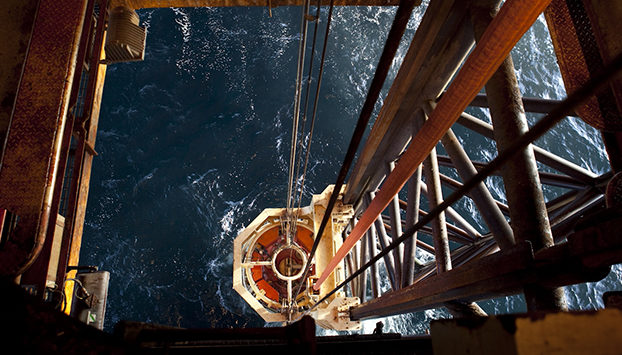
Volatile oil prices are hindering global M&A deals by creating uncertainty, widening the asset valuation gap between buyer and seller, and making companies re-think their strategies, analysts said.
Wood Mackenzie said these factors combined at the end of last year to drop the “deal count” to its lowest level since the first quarter of 2015. Brent crude sank from $85 per barrel at the start of October 2018 to just over $50 in late December due to fears of oversupply and a global slowdown in economic growth.
But a slide in the share prices of exploration and production companies means there are potential bargains to be had.
Greig Aitken, director, M&A research at Wood Mackenzie, said: “It is difficult to see 2019 being a bumper period for upstream M&A.
“If volatility cedes to stable but lower oil prices, history suggests we’ll see a relatively sluggish year – we tend to see more deals when confidence and investment are high.
“That said, in any environment there are always motivated sellers and opportunistic buyers, players looking to re-engineer portfolios and companies with the desire and capacity to make counter-cyclical moves.”
Majors and IOCs will continue using acquisitions and disposals to tighten portfolios
Since the downturn, the Majors have worked exceptionally hard to focus businesses on long-life, low-cost growth assets.
That will continue this year, Mr Aitken said, adding: “Expect more country exits, more portfolio high-grading and more exits from legacy assets.
“Acquisitions can still be expected – both bolt-ons to existing operations and more material purchases in core target areas.
“However, there are large discovered resource opportunities which will compete for the majors’ capital. In particular, Brazil’s 9 billion barrels of oil equivalent surplus volumes of the transfer of rights contract, and Qatar’s North Field expansion.”
Mr Aitken added: “Most North American-headquartered independents have become increasingly North America-focused in recent years.
“We expect concentration to increase in 2019. In a low price environment, companies may rein in budgets so capex is organically funded, but overseas disposals will support balance sheet strengthening and shareholder distributions.”
Still more big deals to come in the Permian
Scale was the word of the year in the Permian in 2018, as Concho and Diamondback spent a combined $20 billion catapulting themselves into the big league. Small-cap pure-play Resolute was exploring strategic alternatives when larger peer Cimarex swooped in November.
“Remaining small and mid-cap pure-plays will also be asking themselves some serious questions. In a play that is increasingly being dominated by larger companies, how do smaller companies compete for services? How do they compete on productivity and costs? How do they remain relevant to investors? We expect more combinations,” Mr Aitken said.
“But M&A activity won’t be limited to the listed pure-plays. Though many of the larger privately-held positions were taken out during Permania in 2016/2017, at least two material positions are piquing interest. Encap-backed Felix Energy’s Delaware basin position would offer materiality to most buyers.
“The true giant is Endeavor Energy. With over 300,000 net acres in the Midland basin, it is no surprise that Chevron, ExxonMobil and Shell are rumoured to have kicked Endeavor’s tyres. A deal in 2019 is not a foregone conclusion, but if Endeavor’s backers want a near-term exit, the IPO route looks a non-starter under current market conditions.”
Corporate consolidation gathers steam
A continued focus on discipline means that a recent uptick in corporate-level consolidation will likely gather pace. Balance sheets can be quickly strengthened through corporate M&A, particularly if the deal currency is equity. Diversifying transactions can reduce the risk of exposure to worrisome pricing differentials. Increased size boosts operations through economies of scale.
“Moreover, three years of discipline has failed to provide tangible rewards for many shareholders; a late 2018 sell-off has left many companies trading at, or close to, multi-year lows. Small and mid-caps will be the primary targets. But combinations between large Independents should not be ruled out. North America is likely to be the hub of consolidation, due to the unrivalled diversity of its corporate landscape,” he added.
Share price weakness will attract opportunistic acquirers
The E&P share price slide presents a unique opportunity. There are potential bargains out there – good-quality companies which are undervalued due to cyclical, external factors.
Mr Aitken said: “The question is, who’s in the best position to take advantage of this? Cash buyers would certainly accrue the biggest benefits, by avoiding paying for acquisitions using similarly under-valued stock. That requires a balance sheet which is strong enough to withstand a period of low prices.
“Some national oil companies (NOCs) may have the firepower to bargain hunt, but there is no sign that the Chinese NOCs still have the appetite for big deals. Other Asian and Middle Eastern NOCs are more likely candidates, based on recent form and clear intentions.
“Private equity, sovereign wealth funds and other investors are well placed. Discounted market valuations are exactly the type of scenario in which these companies can generate value. “
Underlying valuations to remain flat
The long-term assumptions underpinning valuations tend to be less volatile than short-term oil prices. However, upside pressure will be weak. Buyers will be looking to pick up keenly-priced assets; competition will be less prevalent in many regions. This will lead to a wider variability in agreed prices – more like 2018 than 2017, in that regard.
Recommended for you
